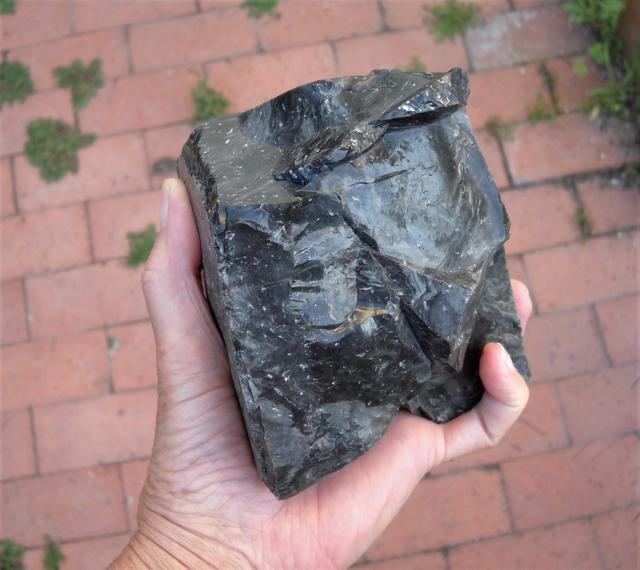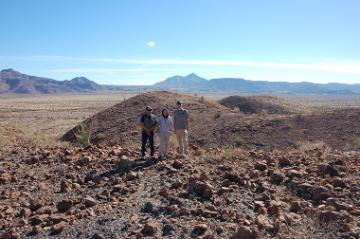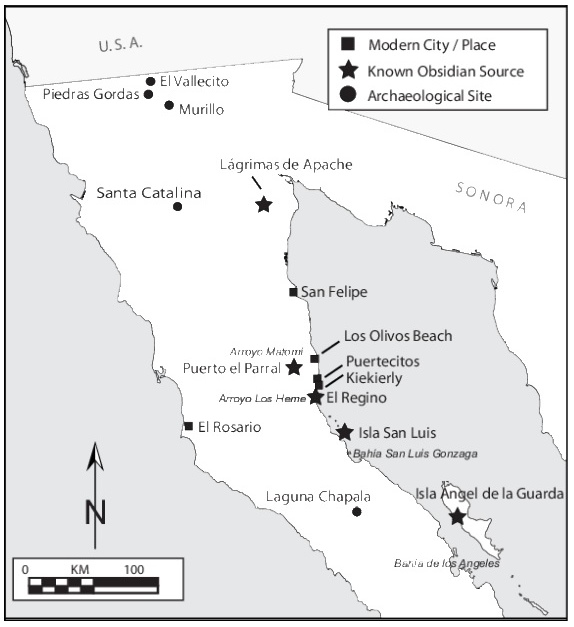gorton
Newbie
Posts: 4
Registered: 4-14-2019
Member Is Offline
|
|
Sources of obsidian?
During this winter's exploring in of canyons along the east slope of the San Pedro Martir I found a knapping site with clear quartz, slate?, and
obsidian flakes. I was surprised to see obsidian and was wondering if anyone with knowledge of the local anthropology might have insight on the extent
of trade and closest sources of obsidian.
|
|
|
David K
Honored Nomad
        
Posts: 65411
Registered: 8-30-2002
Location: San Diego County
Member Is Offline
Mood: Have Baja Fever
|
|
A paper published by Lee Panich, PhD has such a map of obsidian sources in Northern Baja, used to track Native trade routes. When I get back to my PC,
I will post the link if you don't find it first. I think it was his paper on Mission Santa Catalina where he did a dig in 2007.
|
|
|
mtgoat666
Platinum Nomad
       
Posts: 20396
Registered: 9-16-2006
Location: San Diego
Member Is Offline
Mood: Hot n spicy
|
|
Large Obsidian sources are azufre (near santa rosalia) and salton sea. There may be smaller sources elsewhere.
Woke!
Hands off!
“Por el bien de todos, primero los pobres.”
“...ask not what your country can do for you – ask what you can do for your country.” “My fellow citizens of the world: ask not what America
will do for you, but what together we can do for the freedom of man.”
Pronoun: the royal we
|
|
|
wilderone
Ultra Nomad
    
Posts: 3894
Registered: 2-9-2004
Member Is Offline
|
|
The island off Cinco Islas (Isla Lobos I think) has tons (literally) of obsidian on the beach. Here is a small chunk I picked up during a kayaking
trip.


I'm sure there were regular routes from the mountains to the gulf, and trading with other tribes.
|
|
|
David K
Honored Nomad
        
Posts: 65411
Registered: 8-30-2002
Location: San Diego County
Member Is Offline
Mood: Have Baja Fever
|
|
OK... here we go...
https://www.scu.edu/cas/anthropology/news-and-events/stories...

Dr. Panich stands with his Mexican colleagues at a prehistory obsidian quarry in Baja California, Mexico.

Here is the paper, with a slightly larger map: https://scholarcommons.scu.edu/cgi/viewcontent.cgi?article=1...
[Edited on 4-15-2019 by David K]
|
|
|
bent-rim
Nomad
 
Posts: 294
Registered: 7-31-2007
Location: Marin County
Member Is Offline
Mood: Living la vida mota
|
|
Worried about the Whitewalkers?
|
|
|
David K
Honored Nomad
        
Posts: 65411
Registered: 8-30-2002
Location: San Diego County
Member Is Offline
Mood: Have Baja Fever
|
|
Winter is coming? 
"Dragonglass" is what obsidian is called in Westeros...
https://gameofthrones.fandom.com/wiki/Dragonglass
|
|
|
4x4abc
Ultra Nomad
    
Posts: 4454
Registered: 4-24-2009
Location: La Paz, BCS
Member Is Offline
Mood: happy - always
|
|
Punta Pulpito in the south
the entire northern coast is a source of obsidian - it floats when still attached to the pumice part (pumice = foamed obsidian)
Harald Pietschmann
|
|
|
freediverbrian
Senior Nomad
  
Posts: 625
Registered: 2-24-2007
Location: Papas Gonzaga Bay
Member Is Offline
|
|
Just hope those south of the wall don't us white walkers aka gringos
|
|
|
bajaguy
Elite Nomad
     
Posts: 9247
Registered: 9-16-2003
Location: Carson City, NV/Ensenada - Baja Country Club
Member Is Offline
Mood: must be 5 O'clock somewhere in Baja
|
|
Gurrero Negro
I have found obsidian flakes around the Ejido whale center south of Gurrero Negro
|
|
|
BajaMama
Super Nomad
   
Posts: 1108
Registered: 10-4-2015
Location: Pleasanton/Punta Chivato
Member Is Offline
Mood: Got Baja fever!!
|
|
That is the best White walker/Mexico meme ever!
[Edited on 4-16-2019 by BajaMama]
|
|
|
ehall
Super Nomad
   
Posts: 1906
Registered: 3-29-2014
Location: Buckeye, Az
Member Is Offline
Mood: It's 5 o'clock somewhere
|
|
Found big chunks of it in Arroyo Grande .
|
|
|
BajaMama
Super Nomad
   
Posts: 1108
Registered: 10-4-2015
Location: Pleasanton/Punta Chivato
Member Is Offline
Mood: Got Baja fever!!
|
|
There is a lot of lava rock south of San Ignacio, so I would think there would be some spots of obsidian here and there.
|
|
|
Fatboy
Senior Nomad
  
Posts: 805
Registered: 6-28-2005
Member Is Offline
|
|
Interesting paper, sounds like some boundaries for trading obsidian was a linguistic in nature.
|
|
|
gorton
Newbie
Posts: 4
Registered: 4-14-2019
Member Is Offline
|
|
"Linguistics in nature?", please clarify..
|
|
|
Fatboy
Senior Nomad
  
Posts: 805
Registered: 6-28-2005
Member Is Offline
|
|
I would think that an item being traded would have been limited by geographical boundaries.
For example, obsidian would be traded or procured from any one given source until it was either too far away or some sort of geographical obstacle
such as a mountain or river or the ocean got in the way. In other words you go to the source that was easiest to get to.
What the paper says is that in some cases it appears as if the obsidian was traded in an area with common linguistic as being the defining borders.
That perhaps one group would go further away to get obsidian then to trade with a closer neighboring group that spoke a different dialect.
|
|
|
wilderone
Ultra Nomad
    
Posts: 3894
Registered: 2-9-2004
Member Is Offline
|
|
The scholarly paper is filled with "ideas" (not proof), cautionary statements regarding the limitations of samples, and an attempt to homogenize a
plethora of other research materials to further his speculation, and “Much scholarly debate”. E.g., Stating: “Obsidian was used widely in the
region’s late prehistoric and early historic periods (ca. A.D. 500 –1840), and the distribution of obsidian artifacts from particular sources may
offer insight into local hunter-gatherer settlement patterns ….” And “Given that Baja California obsidian studies remain in their
infancy….”. The data seems to discount that the Baja California peninsula has been occupied for 10,000-12,000 years – and all inhabitants were
making and using tools, and were nomadic. For all its mapping, etc. efforts, I don’t feel that paper sheds much light on the subject. There were
different cultures with different dialects, there were a limited number of obsidian sources, all peoples roamed to where they would find food and
water. They came from the mountains to the oceans for seasonal opportunities and possibly they mixed with others and traded any number of items. It
is known that Macaw feathers and turquoise from Mexico were found in Arizona and Utah. Trade routes can run far and wide. I personally believe that
“scholars” and “PhD” and the like are pressured to publish articles to support their grant money that enables them to pursue a personal
agenda. IMO L. Panich is driven by his interest in Baja – just like the rest of us – and his observations and personal experience is limited, and
thus, his paper has little to offer (except the accumulation of other cited research). Just my opinion. Would have been a lot more illustrative if
there was a map simply showing the locations of the found artifacts and their source, since they had that capability. (“geological sources of
obsidian artifacts were determined through X-ray fluorescence (XRF) spectrometry, using a combination of portable (pXRF) and desktop instruments.”)
Attempting to put the linquistic circle into the necessity square is a rookie mistake (prejudice).
[Edited on 4-19-2019 by wilderone]
|
|
|
Fatboy
Senior Nomad
  
Posts: 805
Registered: 6-28-2005
Member Is Offline
|
|
Wilderone -- I have no dog in this fight and it is not my strong point to boot .... With those thoughts in mind I find your arguments intriguing.
..."ideas" (not proof) --- Yes, it is a paper where he places forth many 'ideas' and few solid examples of proof because as your quotes show there is
a very small sample size and there is not a lot of study on the matter and any early paper would be full of ideas without the proof to sustaniate
them.
...data seems to discount ...Baja ...been occupied for 10,000 - 12,000 years --- I did not read anything that suggested that, he makes a point of
saying he ASSUMES that most of his material comes from sites dated from 500 A.D to 1840. He never implies or states that is how long the area has been
populated.
...that Macaw feathers and turquoise from mexico where found in Arizona and Utah .... Is a Red Herring. My comment was that SOME trade appeared to be
influenced by linguistic boundaries as much as by geographical ones. The author would agree trade routes can 'run far and wide' but he said it is a
possibility and list a few other studies that suggest it happens in other areas and it might happen here some of the time.
...is a rookie mistake .... Since all such undertakings have to start somewhere, and I am not saying this is the first, or even one of the first
papers on the subjects, it seems that he is simply stating some ideas based on some research on a very small sample size. He goes on to state that
more work needs to be done and that further study should consider social
distance alongside the effective distance.
My response earlier in this thread to the paper was that I have never considered linguistics as a barrier to trade when in hindsight it makes perfect
sense.
|
|
|

